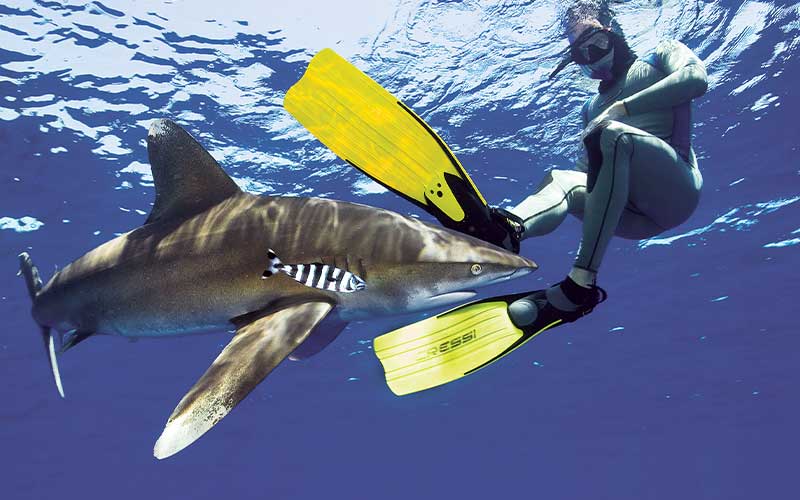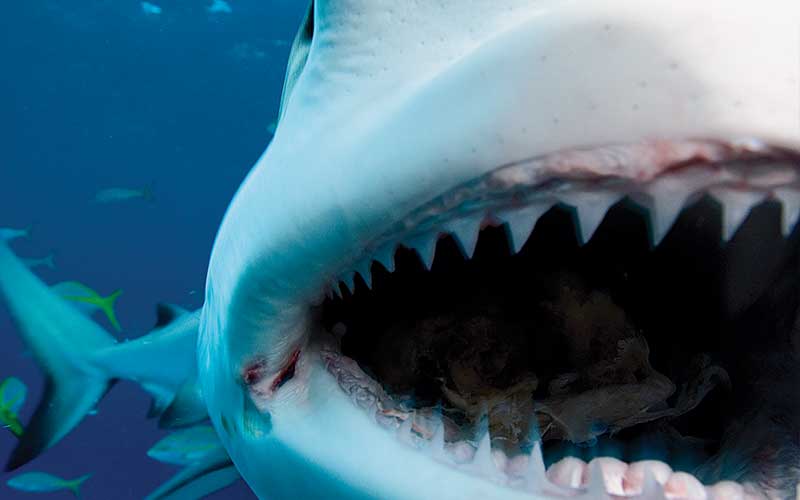No matter how careful they are, sooner or later most divers are stung, bitten, punctured or poisoned by a marine animal. While healthy respect for marine life and the environment generally are protective, accidents occur and serious afflictions may result.
Sharks are commonly thought of as the marine animal most likely to bite or attack, but in truth there are many marine animals that may injure divers. Creatures such as barracuda, seals, otters and eels — while not normally aggressive — all may react defensively and bite humans.
Shark Avoidance and Attack Prevention
It’s relatively common for divers to seek out and swim with sharks, but there may be circumstances in which it is preferable to avoid contact altogether. As with so many other scuba situations, prevention is the best solution to most problems. However, there are exceptions, and it’s important to know how to handle the challenge if there’s no option but to interact.
Avoidance
There are a few things you can consider before you ever enter the water. Certain geographic areas may be known to have significant shark populations or a history of documented shark attacks. Sanitation waste outlets, breeding inlets, deep channels and areas with dark or turbid water or drop offs may be areas frequented by larger sharks. No matter the surroundings, swimmers and divers should remain in groups, because isolated humans may be at higher risk for shark attack. Be aware, too, that shark attacks may occur with higher frequency at dawn and dusk. Finally, it’s also wise to avoid wearing anything shiny in the water; you don’t want your favorite jewelry mistaken for a fishing lure. This is particularly important to avoid barracuda bites.
When you’re in the water, be aware of the presence of natural sources of shark food, such as seals or sea lions. Pinnipeds playing or swimming in the water does not necessarily mean an absence of sharks. Don’t stay in areas in which blood is flowing freely in the water. If you are injured, exit the water immediately; if you are fishing, killed fish should be removed from the water, or at least isolated from divers in the water, as soon as possible. Don’t ever try to feed a shark; if done at all, it should be only by a trained expert.

Defense
It is always unwise to tease or corner a potentially aggressive marine animal. If you are in the water with sharks, show them the healthy respect they deserve; most of the time they are content to share the water column with no fuss whatsoever.
However, if you do find yourself in a situation where there is concern for attack, continually face the shark and calmly leave the area with controlled movements. Don’t panic, and avoid splashing behaviors. Don’t bolt for the surface, either; remain submerged, and seek cover with posterior protection, such as a crevice in a coral reef. This allows you a position of defense without worrying about an attack from behind. Most sharks are stealth predators, and being able to keep them in your line of sight is helpful.
If an attack does come, sharks may be repelled by blunt blows to the head, nose or eyes; these are sensitive areas with a high density of sensory nerve fibers. Use of weapons such as spear guns, knives or bang sticks is not recommended, especially by those untrained in their use. Inappropriate use of a weapon can cause unnecessary injury to both you and the animal that threatens you.
There are a variety of products on the market that claim shark repellent qualities; they may have varying degrees of effectiveness, but practical application and evaluation have thus far been limited and, in some cases, inconclusive.
Care of the Bite/Attack Victim
If the unavoidable (or totally unexpected) occurs, traumatic injuries caused by marine life can present challenges both to immediate and longer-term medical management. Shark attacks in particular can result in significant trauma and substantial blood loss. Initial focus should be on providing basic life support as necessary, followed by stabilizing the patient for transport to definitive emergency care.
Begin by assisting the victim out of the water. Apply direct pressure to any bleeding sites as quickly as possible. A barrier such as a cloth or gauze pads may be helpful, and gloves should absolutely be worn whenever possible to protect against bloodborne disease. Do not release pressure to check on the wound for at least 10 minutes, and if a bandage soaks through with blood, place another directly on top of it and continue to hold pressure. If the injured area is on an extremity, elevate the body part above the level of the heart. It is important not to apply bandages in a fashion that restricts circulation beyond the dressing. The tips of fingers and toes should be pink, not pale or purple.

Almost all bleeding will stop with sustained direct pressure and immobilization; however, some wounds, particularly those involving amputation or damage to large blood vessels, may bleed uncontrollably. In these cases, a tourniquet should be considered. It is highly recommended that you have training in applying tourniquets before attempting to do so, as tourniquets are potentially hazardous interventions that risk loss of limb. Nearly anything may be used as a tourniquet: a length of rope, cord or webbing, but it must be well-padded to reduce the risk of severe local tissue injury. Apply the tourniquet between the heart and the injury as close to the bleeding site as possible. Tighten it only until bleeding is controlled. Loosen tourniquets for a moment every 10 to 15 minutes to assess whether they are still necessary for bleeding control. If the bleeding is brisk, retighten the device. If bleeding has ceased to the degree it can be readily controlled by direct pressure, remove the tourniquet and apply direct pressure, though keep the tourniquet handy in case it needs to be reapplied.
If internal organs or tissues are protruding through an injury, do not attempt to push them back inside the body unless it is absolutely necessary for transport. All wounds to the chest should be covered with a dressing. Wounds that appear to be bubbling or “sucking” should be covered with a dressing taped and sealed on three sides. The fourth, untaped side serves as a flutter valve that allows air to escape from the chest. Without this flutter valve, air pressure may develop in the space surrounding the lung, preventing lung expansion.
A splint may be used to immobilize an injured extremity to reduce pain, limit blood loss and protect a fractured limb. Aside from ready-made splints, a variety of objects may be used to improvise (see “Field Management of Musculoskeletal Injuries”). Be careful that splints and dressings are not applied too tightly and that circulation to the extremity is not compromised.
If the wound is minor, you may care for it by gently cleansing it with antiseptic solution, a dressing and prophylactic antibiotics, per your physician’s instructions; however, any significant shark bite will likely require expert emergency medical care.
Many divers relish the opportunity to swim and interact with potentially aggressive marine animals. These interactions are almost uniformly uneventful; careful attention to both personal behavior and the behavior of the animals, as well as respect for the animals, will generally prevent the vast majority of attacks. However, an awareness of avoidance techniques and injury treatment principles will serve divers well in the rare but potentially deadly instances when injuries do occur.
© Alert Diver — Q4 Fall 2010